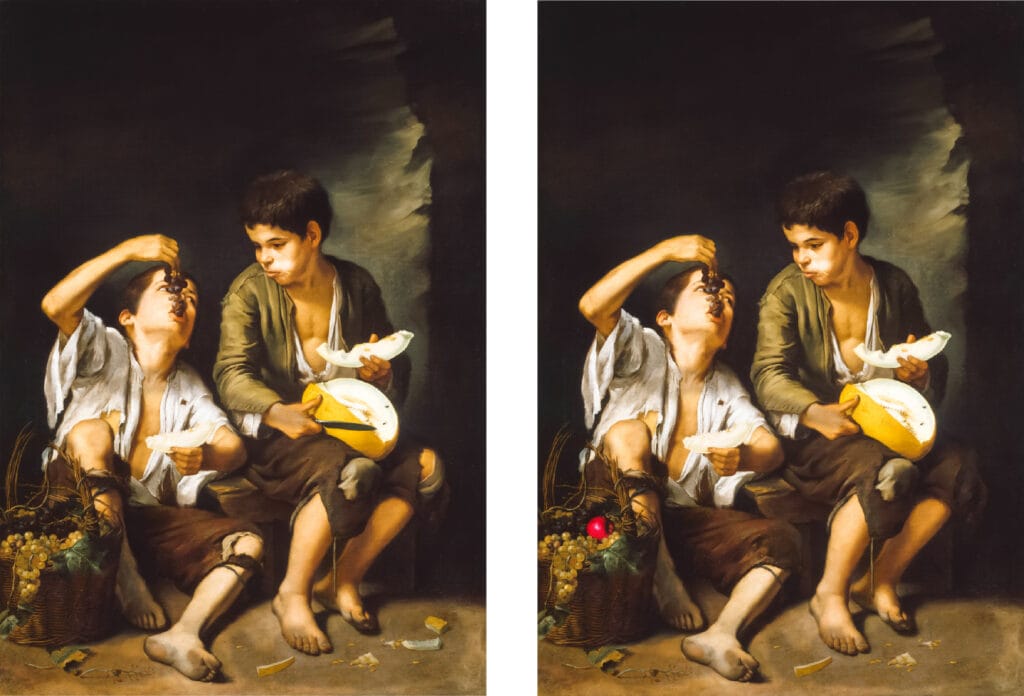Table of Contents
Not all Spot the Difference puzzles are created equal — and one of the biggest differences lies in the art style. From soft watercolors for young children to dynamic graphic scenes for teens, the way a puzzle looks changes how it’s experienced. The right art style can make a puzzle feel inviting, calming, exciting, or smart. It’s more than visual decoration — it’s the emotional and cognitive entry point for the player.
In this guide, we’ll explore the art styles that best suit each age group, explain why they work, and offer examples you can use — whether you’re creating spot the difference puzzles, curating a catalog, or choosing one for a loved one. We’ll also look at timeless, cross-generational styles — including the classic art masterpieces that power our own collection at Classic Art Puzzles.
Let’s begin with the basics: why art style matters in the first place.
Why Art Style Changes the Spot the Difference Puzzle Experience
The purpose of a Spot the Difference puzzle is to engage the player visually and mentally. But different people look at images in different ways depending on their age, developmental stage, visual processing ability, and personal taste.
Art style influences how easily someone can:
- Understand the image
- Notice differences
- Enjoy the mood or theme
- Stay engaged with the puzzle
The goal isn’t just to make a puzzle hard or easy — it’s to make it appealing and accessible. Matching the visual style to the age of the player is key.
For Toddlers (Ages 2–4): Bold, Bright, and Simple
Recommended Styles:
- Flat-color cartoons
- Minimalist illustration
- Vector art with clear outlines
- High-contrast visuals with simple shapes
Why These Work:
At this stage, children are learning to process visual information. They benefit from bold lines, big objects, and bright colors. The image should have low complexity, with no busy textures or shadows. Faces and emotions in characters help toddlers engage.
Avoid: Sketchy lines, small details, dull colors, or visual clutter.
Popular Puzzle Themes Using This Style:
- Cartoon animals
- Happy food faces
- Toy scenes
For Young Children (Ages 5–7): Playful and Expressive Illustration
Recommended Styles:
- Storybook-style art
- Soft digital illustration
- Whimsical cartoon drawings
- Bold outlines with more detail
Why These Work:
Kids in early school years love images that spark imagination — dragons, castles, space ships, fairy tales. They can handle more visual content than toddlers, but still benefit from strong contrasts and clear visual cues.
Faces, movement, and playful scenes help with narrative thinking and engagement.
Avoid: Realistic shadows, muted tones, or overly complex backgrounds.
Popular Puzzle Themes Using This Style:
- Princesses and dinosaurs
- Jungle animals in silly poses
- Superhero kids
For Preteens (Ages 8–12): Graphic Detail and Controlled Complexity
Recommended Styles:
- Comic book illustration
- Anime-style light shading
- Semi-realistic digital art
- Clean vector scenes with layered details
Why These Work:
Preteens are developing longer attention spans and more interest in logic and mystery. They enjoy spot the difference puzzles with clever visuals and layered detail — but not too much noise.
A well-structured image with variety (foreground, midground, background) helps make the puzzle feel like a mini world to explore.
Avoid: Overly childish visuals, blurred textures, or chaotic design.
Popular Puzzle Themes Using This Style:
- Secret agent scenes
- Video game landscapes
- Fantasy worlds
For Teenagers (Ages 13–18): Stylized, Modern, and Mood-Driven
Recommended Styles:
- Realistic photo-editing
- Anime and manga art
- Bold pop-art styles
- Surreal or dreamlike visuals
- High-contrast illustrations or minimalist aesthetics
Why These Work:
Teens are highly visual and taste-driven. They enjoy spot the difference puzzles that look cool, artistic, or relatable — even if the differences are tough to find. Style matters here: teens respond to design choices that mirror fashion, gaming, film, and digital aesthetics.
Clever layouts, symmetry play, and visual storytelling enhance the experience.
Avoid: Childish themes, flat vector-only design, or forced humor.
Popular Puzzle Themes Using This Style:
- Music and street culture
- Film-inspired scenes
- Stylized cityscapes
For Adults (Ages 18–59): Visual Pleasure and Mental Focus
Recommended Styles:
- High-quality photography
- Impressionist or expressionist painting styles
- Fine art with preserved brushwork
- Stylized illustration (e.g. minimalist or mid-century)
- Elegant collage or montage visuals
Why These Work:
Adults enjoy spot the difference puzzles that offer both mental stimulation and aesthetic satisfaction. This group spans a wide range of tastes — some prefer calming visuals (watercolor, landscapes), others enjoy clever, clean design.
Mood matters. A well-chosen art style can either enhance relaxation or sharpen focus, depending on what the player is looking for.
Avoid: Low-resolution images, garish color schemes, or dated clip art.
Popular Puzzle Themes Using This Style:
- Still life compositions
- Architecture and city views
- Artistic food photography
For Seniors (Ages 60+): Clear, Nostalgic, and Calming Visuals
Recommended Styles:
- Classic realism
- Traditional line-and-wash illustration
- Vintage poster art (1930s–1960s)
- Soft impressionist or decorative painting styles
- High-contrast simplified photography
Why These Work:
Older adults tend to appreciate visuals that feel warm, familiar, or meaningful. Clarity is key — subtle differences are welcome, but the art style should support visibility.
Scenes with emotional resonance, nature, or family-life settings work especially well.
Avoid: High-glare colors, busy patterns, abstract forms, or “gimmicky” visuals.
Popular Puzzle Themes Using This Style:
- Country gardens
- Family kitchens
- Streets of the past
Cross-Generational Art Styles That Work for Everyone
Some art styles transcend age. They appeal to toddlers, teens, adults, and seniors alike — and provide a shared visual language that allows people to enjoy spot the difference puzzles together. That’s why these styles are so powerful for family puzzles, group play, or shared activities.
Best Cross-Age Styles:
1. Classic Art Masterpieces
Whether it’s a Vermeer domestic interior or a bustling Rococo garden party, timeless art offers layered detail, emotional warmth, and visual stories. It invites exploration and sparks imagination — regardless of age.
This is the approach we take at Classic Art Puzzles, where we curate historical paintings — from Baroque to Neoclassicism and beyond — as immersive spot the difference puzzles. These works are not only beautiful; they’re rich in human emotion, meaningful detail, and narrative depth. They invite players to slow down, look closely, and discover a story unfolding in every brushstroke.
Some of the timeless masterpieces we feature include:
- The Death of Socrates – Jacques-Louis David, 1787
- The Lictors Bring to Brutus the Bodies of His Sons – Jacques-Louis David, 1789
- The Return of the Prodigal Son – Rembrandt van Rijn, 1661–1669
- The Calling of Saint Matthew – Caravaggio, 1599–1600
- The Swing – Jean-Honoré Fragonard, c. 1767
- The Musical Contest (A Garden Full of Charm) – Jean-Honoré Fragonard, c. 1754–1755
- The Milkmaid – Johannes Vermeer, c. 1657–1658
These paintings span centuries and movements, yet each offers visual clarity, emotional resonance, and a timeless sense of story. That’s what makes them so well suited to Spot the Difference — they’re more than art; they’re quiet moments, dramatic scenes, or poetic reflections captured in paint.
- Easy to scale in difficulty
- Respectful and calming
- Rich with authentic detail
- Suitable for multigenerational use
By turning these masterpieces into spot the difference puzzles, we create a space where art appreciation meets mindful play — and where generations can connect through quiet observation and discovery.
2. Illustrated Storybook Styles
Bright, clean, and playful — this style is accessible to young children, but charming enough for older players.
3. Nature Scenes in Realism or Impressionism
These offer emotional calm for older players and visual interest for younger ones. Trees, flowers, animals, and clouds are universally enjoyable subjects.
4. Everyday Life Scenes
Depicting simple things — a room, a park, a bakery — invites all ages to relate and find joy in spotting what’s changed.
Art Styles That Divide Opinion but Still Hold Their Charm
While some art styles appeal universally, others are more polarizing — captivating for some, less so for others. These styles often carry strong cultural, thematic, or aesthetic identities that spark conversation and evoke strong reactions. In the world of spot the difference puzzles, they can still shine for the right audience, offering unique visual experiences and emotional connections.
Examples of Subjective but Beloved Styles:
- Abstract Expressionism – Bold color fields, sweeping brushstrokes, and non-representational forms create a puzzle challenge based on texture, rhythm, and composition rather than literal objects. Enthusiasts find them exhilarating; others may find them elusive.
- Surrealism – Dreamlike and often bizarre imagery from artists like Salvador Dalí or René Magritte invites imaginative thinking, but its layered symbolism can feel puzzling to those preferring straightforward scenes.
- Minimalism – Stripped-down shapes and limited color palettes can make finding differences deceptively difficult. Minimalist puzzles delight those who appreciate clean design but may frustrate players seeking more narrative visuals.
- Pop Art – Vivid colors, bold outlines, and cultural references appeal to fans of mid-20th century style, yet may not resonate with those preferring traditional or historical themes.
- Cubism – Angular, fragmented perspectives create a highly analytical puzzle experience. Some love its intellectual challenge; others find it visually disorienting.
Incorporating these styles into spot the difference puzzles works best when matched to an audience that appreciates their character. They may not be “everyone’s cup of tea,” but for enthusiasts, they offer an enriching alternative to more conventional designs — proving that even divisive art can have a loyal following.
Final Thoughts: Visual Style Is the Gateway to Engagement
A well-crafted spot the difference puzzle doesn’t just challenge the eyes — it welcomes the mind. The art style is what opens that door. When you match the visual language to the player’s age and interests, the puzzle becomes smoother, richer, and more enjoyable.
Whether you’re designing puzzles, curating a collection, or simply choosing a game for family fun, remember: art style is more than background — it’s the soul of the puzzle.
Explore our thoughtfully curated Spot the Difference puzzles — from classical masterpieces to family-friendly visual stories — available in interactive flipbook formats for every generation.
Play Classic Art Spot the Difference | Find 5 Differences

View Solution




